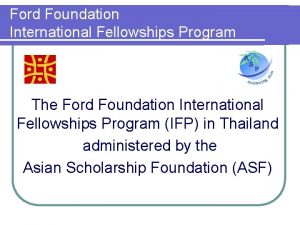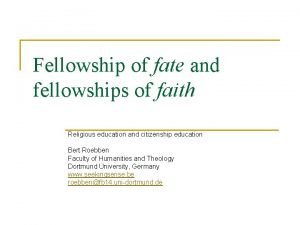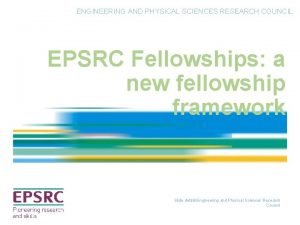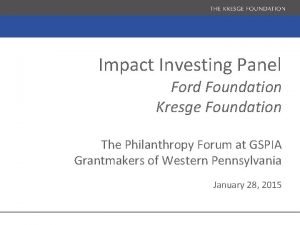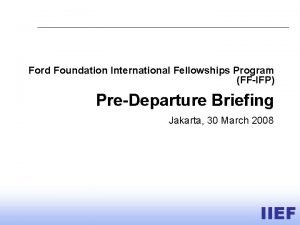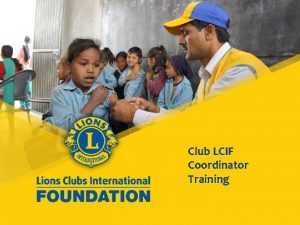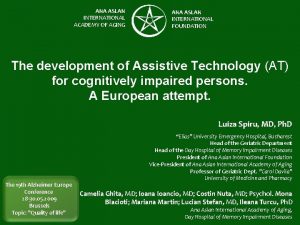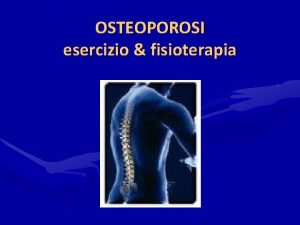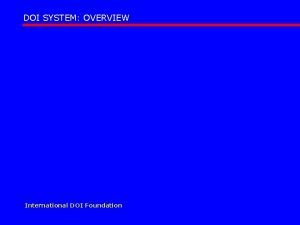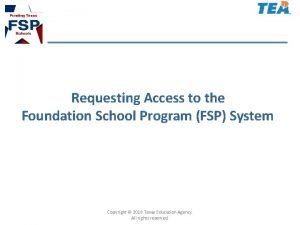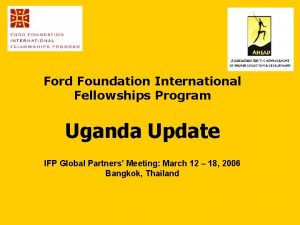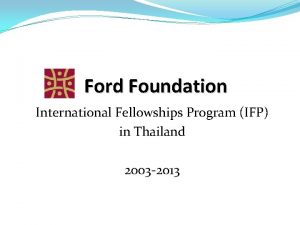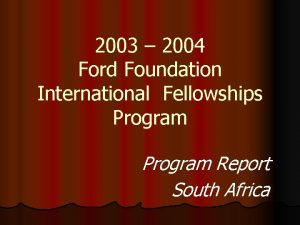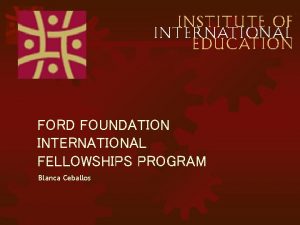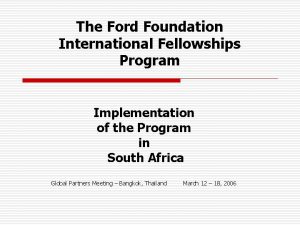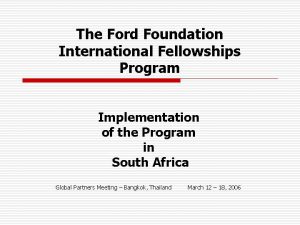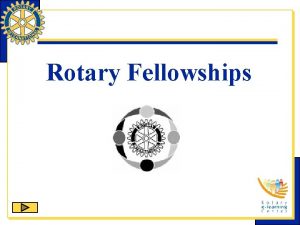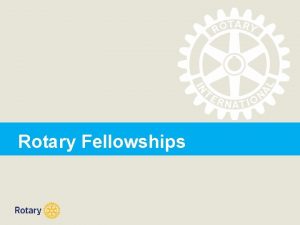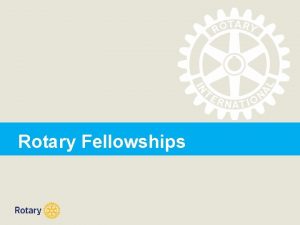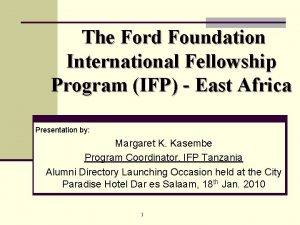The Ford Foundation International Fellowships Program Reflective Analysis











































- Slides: 43

The Ford Foundation International Fellowships Program Reflective Analysis of the Program Strategies & Activities in South Africa Regional Meeting - Accra, Ghana Nov, 30 – Dec, 4 2004

Contents 1. 2. 3. The Selection Process Support & Monitoring Cohort Building; Leadership & LSJ’s 4. Placement 5. Alumni

The Selection Process Targeting – Defining the Target Group What has Worked: • Eligibility based on academic entry level; community involvement; previous lack of access to higher education; from the identified target areas Identified Challenges: • The growing trend towards urbanization • The changing dynamics of SA society • Linking key development needs to the identified, related human resource requirements in the country

The Selection Process Provincial Area 2002/3 2003/4 2004/5 Eastern Cape 49 19 34 Kwa. Zulu Natal 41 31 47 Limpopo 39 30 17 Mpumalanga 5 1 7 North West 5 3 5 Northern Cape 1 0 2 Free State 6 4 9 83 19 40 100 51 115 Western Cape Gauteng

The Selection Process Targeting – Defining the Target Group Proposed Solutions: • Consulting the major role players in the key development areas to identify the human resource requirements for meeting the country’s development needs so that potential applicants working in these areas are targeted

The Selection Process Outreach/Recruitment – Strategies What Has Worked: • Advertising in national & regional newspapers with readership in the current target group • The dedicated website • Distribution of Program information materials (brochures, posters) • Encouraging Fellows-Elect & Fellows to act as ambassadors for the Program by identifying & recruiting suitable candidates

The Selection Process Outreach/Recruitment – Strategies Identified Challenges: • High advertising costs in SA • Advertising period needed to reach target group in the most remote areas • Selective dissemination of information in rural areas due to the desire to capitalize on limited higher education opportunities • The trend towards urbanization

The Selection Process Outreach/Recruitment Strategies Proposed Solutions: • Exploring the possibility of advertising in NGO publications, student newsletters etc • Beginning a month earlier to extend the outreach period • Preparing a Power Point presentation on the Program to be put onto disks & distributed to the major role players in the key development areas & all other contacts identified as suitable recruitment partners

The Selection Process Selection Criteria What Has Worked: • The criteria used has been in line with the guidelines provided for meeting the Program objectives • Determining an order for ranking the agreed criteria applied and then evaluating applications from the current target group against these so as to identify the best possible candidates

The Selection Process Selection Criteria Identified Challenges: • Basing the selection criteria on the link between the identified key areas of development in the country and the human resource requirements for meeting these • Focusing the evaluation of an application on the candidate’s commitment and ability to contribute to the main development needs

The Selection Process Selection Criteria Proposed Solutions: • Identify & consult with major players in the key areas of development as a means of establishing national & provincial human resource requirements and developing partnerships that could provide future employment opportunities for Alumni • Review the criteria for defining the target group and subsequent selection of applicants to shift the focus of the entire selection process to that of meeting the identified human resource requirements in the key development areas of the country

The Selection Process The Selection Procedure What Has Worked: • The procedure applied has ensured all applicants of a fair evaluation before & during the interview phase • The affinity of members of the Selection Committee to the Program objectives & their related experience in the fields of study as reflected in the caliber of the candidates they have selected • Scheduling interviews to ensure candidates are grouped according to the level of their proposed degree so that evaluation is based on the same proposed academic level

The Selection Process The Selection Procedure Identified Challenges: • Reading & evaluating all applications thoroughly within the limited time available • Ensuring evaluation is based on the same selection criteria during each phase of the procedure and that any specific recommendation notes are recorded & forwarded throughout the procedure

The Selection Process The Selection Procedure Proposed Solutions: • Revising the guideline document used during the selection procedure to include the agreed ranking & scoring of the criteria applicable and an indication of the national & provincial human resource requirements in the key fields of development • Reviewing the content & structure of the application form so that the reader can easily extract & assess the relevance of the information recorded by an applicant

The Selection Process The Interview Panel What Has Worked: • Members have served according to the agreed periods • The affinity of the panel to the Program objectives & their experience in the fields of study • The procedure followed to ensure the panel members are able to prepare adequately for the interviews • The Panel members adherence to the interview schedule & the review assessment done at regular intervals to ensure every candidate is evaluated fairly

The Selection Process The Interview Panel Identified Challenges: • Getting the Selection Panel to record scores and then to use these more objectively in support of their nominations! Proposed Solution: • Redesigning the candidate evaluation form and stressing the need for recording scores & comments to facilitate the completion by IP staff of the IFP Individual Endorsement template for submission to the IFP Secretariat after the interviews

The Selection Process Needs Assessment & PAT What Has Worked: • The content of the application form has provided an initial indication of the level of the writing & research skills of the applicant • The Panel members’ experience and ability in identifying any additional skills development needs required for completing further studies successfully

The Selection Process Needs Assessment & PAT Identified Challenges: • Developing an assessment tool that forms an integral part of the Program designed to measure a Fellow. Elect’s skills against a universally accepted standard at MA & Ph. D levels • The provision of training in the required areas of development that is cost effective and easily accessible to the Fellows-Elect

The Selection Process Needs Assessment & PAT Proposed Solutions: • Working with a local university to develop an assessment exercise that will assist Fellows-Elect in identifying areas in which they personally have a development need • Using the e-learning methodology for developing and providing training that is learner focused, cost effective and easily distributed to Fellows-Elect

Support & Monitoring Regular, Emergency & Academic What Has Worked: • Having a schedule based on the various phases and requirements of the Program for contacting Fellows. Elect & Fellows • The convenience & cost effectiveness of using emails to carry out support & monitoring activities • Keeping records of all support & monitoring activities in the Fellows-Elect & Fellows individual files

Support & Monitoring Regular, Emergency & Academic Identified Challenges: • Managing the support & monitoring activities as the number of Fellows-Elect & Fellows joining the Program increases • Recognizing a potential problem developing, which is not always easy with written/telephonic communications • Ensuring Fellows-Elect & Fellows take responsibility & ownership of the monitoring process as part of their leadership skills development

Support & Monitoring Regular, Emergency & Academic Proposed Solutions: • Considered delegation of activities & better utilization of the facilities on the Program database • Providing Fellows-Elect & Fellows with a guideline on the monitoring requirements in terms of their Grant Agreement • Developing time management exercises for the predeparture orientation that require Fellows to prepare, structure & submit a schedule for meeting these requirements

Support & Monitoring Sandwich Programs What Has Worked: • Providing support & guidance to Fellows-Elect & Fellows in their research on courses that will be available within their study period & that enhance their study objectives • Monitoring progress in these activities to assist Fellows in being prepared well in advance

Support & Monitoring Sandwich Programs Identified Challenges: • That a Fellow considers a sandwich program for its relevance to the study objectives and availability within the study period • That Fellows do not rely on IP staff to do the necessary planning & preparation for integrating a sandwich program into their study period

Support & Monitoring Sandwich Programs Proposed Solutions: • Information given to Fellows-Elect during the postselection orientation includes a comprehensive list of what study programs are offered by local & international institutions • Ensuring the cooperation agreement with local universities includes the need to provide Fellows with support in selecting appropriate sandwich programs

Support & Monitoring Alumni Identified Challenges: • Keeping in contact with Alumni, especially where they take up employment opportunities offered in areas unrelated to the Program • For Alumni to take responsibility & ownership of their future participation in & contribution to the Program

Support & Monitoring Alumni Possible Solutions: • Discussions with all partners to the Program to establish a strategy for the post-program period and the roles each partner should play in implementing these • Encouraging Alumni to form/join an association & spear-head activities that will ensure their experience and potential to support other members of the Cohort are not lost to the Program

Cohort Building, Leadership & LSJ’s Cohort Building Activities What Has Worked: • Involving current Fellows-Elect & Fellows in developing & facilitating activities to highlight the purpose and benefits of building a Cohort • Encouraging the Fellows-Elect & Fellows to use the networks established for sharing information & providing support to each other during the various phases of the Program • The efforts of individuals to build the SA Cohort

Cohort Building, Leadership & LSJ’s Cohort Building Activities Identified Challenges: • Keeping motivation levels at those created during the cohort building activities held during the postselection orientation • Providing the framework for Fellows-Elect & Fellows to take responsibility & ownership of the development of the SA Cohort and its contribution to members of both the local & international Cohort

Cohort Building Leadership & LSJ’s Cohort Building Activities Proposed Solutions: • Continued use of available Fellows in developing & facilitating appropriate activities but providing a brief outlining the objectives these will need to meet sustained motivation; development of proposed actions to be implemented through assigned areas of responsibility & accountability • Encouraging submission of material for posting on the dedicated website

Cohort Building Leadership & LSJ’s Leadership What Has Worked: • Encouraging the development of leadership skills through circulating news on the achievements of Fellows • Providing a platform for Fellows-Elect & Fellows to demonstrate their leadership abilities through assigning facilitation of cohort building activities to those available to participate

Cohort Building, Leadership & LSJ’s Leadership Identified Challenges: • Providing opportunities for Fellows-Elect & Fellows to demonstrate/develop these skills • Fellows-Elect & Fellows taking the initiative for demonstrating their leadership abilities through their active participation in activities that require them to take on a leadership role

Cohort building, Leadership & LSJ’s Leadership Proposed Solutions: • Encouraging Fellows to include exercises that hone in on the development & demonstration of leadership skills during their cohort building activities • Continued support through postings of successes on the website

Cohort Building, Leadership & LSJ’s What Has Worked: • Providing the Fellows who are invited to attend an LSJ workshop with information and guidelines on what to expect and the role they will play as representatives from South Africa • The networking with other Fellows that has resulted in some of the Fellows who have attended having established international connections

Cohort Building, Leadership & LSJ’s Identified Challenges: • Using attendance at a workshop as an opportunity for Fellows to participate in & contribute to the International Cohort • Building the preparation for attendance at a workshop into the Cohort building activities • Encouraging the Fellows to utilize the email facility demonstrated at the workshops more effectively

Cohort Building, Leadership & LSJ’s Proposed Solutions: • Arranging for Fellows who have attended a workshop to develop appropriate exercises for preparing other Fellows still to attend • Providing a platform for Fellows to share their LSJ workshop experiences with members of the SA Cohort • Ensuring all Fellows are familiar with the functioning & purpose of the email facility through a practical demonstration during the pre-departure orientation

Placement Local & International What Has Worked: • All Fellows have been successfully placed • Individual guidance being offered to Fellows-Elect in selecting the region and possible institutions during and after the post-selection orientation • The assistance provided by representatives of the IPP • The contributions made during the placement process by Fellows already placed

Placement Local & International Identified Challenges: • Fellows being adequately prepared prior to departure for the duration that they will be studying – arrangements for family members left behind, making provision for financial obligations etc. • Resignation period for some Fellows being longer than the time available before departure

Placement Local & International Proposed Solutions: • Adequate preparation for the period away is the topic of one of the Cohort building activities facilitated by the Fellows participating in the post-selection orientation • Ensuring Grant Agreements are signed at least 3 months prior to the proposed departure date

Placement Clustering What Has Worked: • The advantage of being able to identify with other IFP Fellows & the emotional & academic support • The cooperation created through strategic university partnerships Identified Challenges: • Nothing as yet

Alumni Communication & Evolving Work What Has Worked: • Encouraging Fellows about to graduate to keep in contact to ensure their participation in future activities • Involving Alumni in strategy planning for the postprogram period

Alumni Communication & Evolving Work Identified Challenges: • The risk of losing the benefits associated with the experiences that Alumni have gained through the lack of employment opportunities in their areas of specialization • Creating an environment in which Alumni can continue to participate in & contribute to the Program

Alumni Communication & Evolving Work Possible Solutions: • Involving Alumni in the strategy plans for postprogram activities and identifying their role in implementing these • Develop partnerships with leading role players in development work taking place in the country with a view to them making use of the knowledge & skills available through the pool of leaders developed through the Program
 Ford foundation international fellowships program
Ford foundation international fellowships program Family medicine procedures
Family medicine procedures Ukri future leaders fellowships round 7
Ukri future leaders fellowships round 7 Ukri flf success rate
Ukri flf success rate Henry wellcome fellowship
Henry wellcome fellowship Fellowships of fate
Fellowships of fate Epsrc fellowships
Epsrc fellowships Ford foundation impact investing
Ford foundation impact investing Iief jakarta
Iief jakarta Pad foundation
Pad foundation Foundation standard 1 academic foundation
Foundation standard 1 academic foundation Preston mason
Preston mason Wise foundation
Wise foundation Lions club international foundation grant
Lions club international foundation grant Ifpo certified protection officer
Ifpo certified protection officer Who is mevlana
Who is mevlana Theoretical foundation of international business
Theoretical foundation of international business Ana aslan international foundation
Ana aslan international foundation Bendaggio
Bendaggio International science foundation
International science foundation International doi foundation
International doi foundation Optimist international foundation
Optimist international foundation Foundation high school program with endorsement
Foundation high school program with endorsement Texas foundation school program
Texas foundation school program Hát kết hợp bộ gõ cơ thể
Hát kết hợp bộ gõ cơ thể Frameset trong html5
Frameset trong html5 Bổ thể
Bổ thể Tỉ lệ cơ thể trẻ em
Tỉ lệ cơ thể trẻ em Voi kéo gỗ như thế nào
Voi kéo gỗ như thế nào Tư thế worms-breton
Tư thế worms-breton Alleluia hat len nguoi oi
Alleluia hat len nguoi oi Các môn thể thao bắt đầu bằng tiếng bóng
Các môn thể thao bắt đầu bằng tiếng bóng Thế nào là hệ số cao nhất
Thế nào là hệ số cao nhất Các châu lục và đại dương trên thế giới
Các châu lục và đại dương trên thế giới Công thức tính thế năng
Công thức tính thế năng Trời xanh đây là của chúng ta thể thơ
Trời xanh đây là của chúng ta thể thơ Mật thư anh em như thể tay chân
Mật thư anh em như thể tay chân 101012 bằng
101012 bằng độ dài liên kết
độ dài liên kết Các châu lục và đại dương trên thế giới
Các châu lục và đại dương trên thế giới Thơ thất ngôn tứ tuyệt đường luật
Thơ thất ngôn tứ tuyệt đường luật Quá trình desamine hóa có thể tạo ra
Quá trình desamine hóa có thể tạo ra Một số thể thơ truyền thống
Một số thể thơ truyền thống Cái miệng bé xinh thế chỉ nói điều hay thôi
Cái miệng bé xinh thế chỉ nói điều hay thôi
